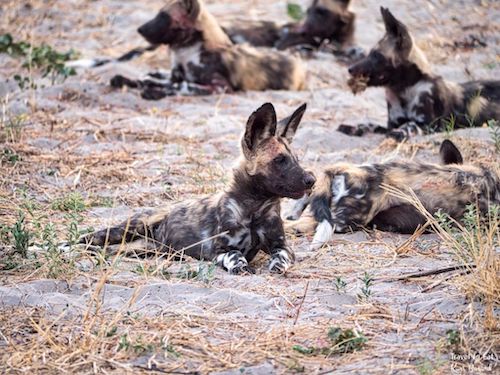
The spotted hyena (Crocuta crocuta), also known as the laughing hyena, is the sole member of the genus Crocuta, one of only four species of hyena and is native to Sub-Saharan Africa. In a previous post, I wrote about wild dogs and I must admit that hyenas and wild dogs look a little like each other, run in packs and are carnivores who also scavenge, catching prey with their teeth. In addition, both eat food quickly and may store it, and their calloused feet with large, blunt, nonretractable claws are adapted for running and making sharp turns. Surprisingly, hyenas are more closely related to felines (cats) than canines (dogs). The hyena is an example of “convergent evolution”. Similar traits can arise when different species live in similar ways and/or a similar environment, and so face the same environmental factors. When occupying similar ecological niches (that is, a distinctive way of life) similar problems can lead to similar solutions.

Ancestral spotted hyenas probably developed social behaviors in response to increased pressure from rivals on carcasses, thus forcing them to operate in teams. The spotted hyena displays greater variety in its hunting and foraging behavior than other African carnivores, it hunts alone, in small parties of 2–5 individuals or in large groups. Compared to other hyenas, the spotted hyena shows a greater relative amount of frontal cortex which is involved in social behavior. Studies strongly suggest convergent evolution in spotted hyena and primate intelligence. Dr Sarah Benson-Amram, of the University of St Andrews, said:
“Hyenas are in fact innovative and able to solve new technical problems. Additionally, spotted hyenas are also quite adept at solving social problems, and have demonstrated cognitive abilities on par with those of primates.”

By 10–12 million years ago, the hyena family had split into two distinct groups: dog-like hyenas and bone-crushing hyenas. The bone-crushing hyenas survived the changes in climate and the arrival of canids (dogs), which mostly wiped out the dog-like hyenas. The spotted hyena is very efficient at eating its prey; not only is it able to splinter and eat the largest bones, it is also able to digest them completely. Spotted hyenas can digest all organic components in bones, not just the marrow. Any inorganic material is excreted with the feces, which consist almost entirely of a white powder with few hairs. One of them can eat 33 lb (15 kg) of meat at a single sitting, quite a feat for a relatively small animal.

Unlike the wild dog, the social system of the spotted hyena is openly competitive rather than cooperative. Spotted hyena clans are more compact and unified than wolf packs, but are not as closely knit as those of African wild dogs. Females dominate males, with even the lowest ranking females being dominant over the highest ranking males. Moreover food is not shared via regurgitation. Spotted hyena societies are more complex than those of other carnivorous mammals, and are remarkably similar to those of primates in respect to group size, structure, competition and cooperation.



The smaller hyena’s ragged appearance compared to the regal air of the lion means hyenas are often seen and portrayed in a negative light while lions are admired and respected. Although hyenas have a reputation as scavengers and thieves, they are active and dangerous predators in their own right, and it’s often more likely that a lion will steal a hyena’s prey than the other way around. Spotted hyenas may kill as many as 70–90% of the animals they eat, while striped and brown hyenas are largely scavengers. Generally, hyenas are known to drive off larger predators, like lions, from their kills, despite having a reputation in popular culture for being cowardly. Both lions and spotted hyenas are social predators who engage in cooperative hunting as well as scavenging, I saw these particular hyenas near a pack of wild dogs who were resting shortly after a kill. Surprisingly, wild dogs usually prevail when facing hyenas.
As always, I hope you enjoyed the post, I hope you will agree that spotted hyenas are much more interesting and more clever than they first appear.
References:
Examples of Convergent Evololution
Convergent Evolution Discussion

